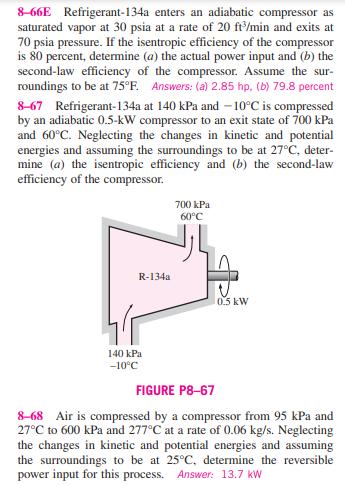Answered step by step
Verified Expert Solution
Question
1 Approved Answer
8-66E Refrigerant-134a enters an adiabatic compressor as saturated vapor at 30 psia at a rate of 20 ft/min and exits at 70 psia pressure.


8-66E Refrigerant-134a enters an adiabatic compressor as saturated vapor at 30 psia at a rate of 20 ft/min and exits at 70 psia pressure. If the isentropic efficiency of the compressor is 80 percent, determine (a) the actual power input and (b) the second-law efficiency of the compressor. Assume the sur- roundings to be at 75F. Answers: (a) 2.85 hp, (b) 79.8 percent 8-67 Refrigerant-134a at 140 kPa and -10C is compressed by an adiabatic 0.5-kW compressor to an exit state of 700 kPa and 60C. Neglecting the changes in kinetic and potential energies and assuming the surroundings to be at 27C, deter- mine (a) the isentropic efficiency and (b) the second-law efficiency of the compressor. 700 kPa R-134a 60C 0.5 kW 140 kPa -10C FIGURE P8-67 8-68 Air is compressed by a compressor from 95 kPa and 27C to 600 kPa and 277C at a rate of 0.06 kg/s. Neglecting the changes in kinetic and potential energies and assuming the surroundings to be at 25C, determine the reversible power input for this process. Answer: 13.7 kW 8-69 Reconsider Prob. 8-68. Using EES (or other) software, investigate the effect of compressor exit pressure on reversible power. Vary the compressor exit pressure from 200 to 600 kPa while keeping the exit temper- ature at 277C. Plot the reversible power input for this process as a function of the compressor exit pressure. 8-70 Argon gas enters an adiabatic compressor at 120 kPa and 30C with a velocity of 20 m/s and exits at 1.2 MPa, 530C, and 80 m/s. The inlet area of the compressor is 130 cm. Assuming the surroundings to be at 25C, deter- mine the reversible power input and exergy destroyed. Answers: 126 kW, 4.12 kW
Step by Step Solution
There are 3 Steps involved in it
Step: 1

Get Instant Access to Expert-Tailored Solutions
See step-by-step solutions with expert insights and AI powered tools for academic success
Step: 2

Step: 3

Ace Your Homework with AI
Get the answers you need in no time with our AI-driven, step-by-step assistance
Get Started


